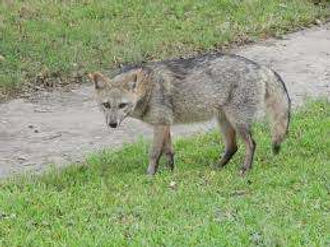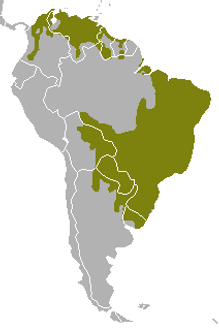Crab-Eating Fox(Cerdocyon thous)
They are also known as the forest fox, wood fox, bushdog or maikong. The crab-eating fox is predominantly greyish-brown, with areas of red on the face and legs, and black-tipped ears and tail. It has short, strong legs and its tail is long and bushy. It may reach an adult weight of 10-17 pounds. The head and body length averages 64.3 cm, and the average tail length is 28.5 cm. This fox weighs between 10-17 lbs.

It is mainly nocturnal and also is active at dusk, spending its day in dens that were dug by other animals. It either hunts individually or lives in pairs; it eats crabs, lizards and different flying animals. It is easy to domesticate and farm, but its fur is not so highly valued as that of other species. The coat is short and thick. Coloration varies from grey to brown, to yellowish, to pale, to dark grey. There is a black streak along the back legs, with a black stripe along the spine. On muzzle, ears and paws there is more-reddish fur. The tail, legs and ear tips are black. The ears are wide and round. The torso is somewhat narrow; legs are short but strong. The dense hairy tail stays upright when they are excited.
Habitat
The crab-eating fox is a canid that ranges in savannahs; woodlands; subtropical forests; prickly, shrubby thickets; and tropical savannahs such as the caatinga, plains, and campo, from Colombia and southern Venezuela in the north to Paraguay, Uruguay and northern Argentina at the southernmost reaches of its range. The crab-eating fox has also been sighted in Panama since the 1990s. Its habitat also includes wooded riverbanks such as riparian forest. In the rainy season, their range moves uphill, whilst in drier times they move to lower ground. Their habitat covers all environments except rainforests, high mountains, and open grassy savannas. In some regions of their range, they are threatened with extirpation.

Diet
The crab-eating fox searches for crabs on muddy floodplains during the wet season, giving this animal its common name. It is an opportunist and an omnivore, preferring insects or meat from rodents and birds when available. Other foods readily consumed include turtle eggs, tortoises, fruit, eggs, crustaceans, insects, lizards and carrion. Their diet is varied and has been found to differ by different researchers, suggesting opportunistic feeding and geographical variation. During the wet season, the diet contains more crabs and other crustaceans, while during the dry season it contains more insects. The crab-eating fox contributes to the control of rodents and harmful insects.
Breeding
Crab-eating foxes are monogamous. They often breed two times a year, 7 to 8 months apart, sometimes with a peak in births in January, February or sometimes March, and again in September to October. November or December is when the reproductive period usually begins, and again in July. Gestation lasts for 52 - 59 days, females giving birth to 2 - 6 cubs. The fox cubs are born with their eyes and ears shut, and without teeth. Their eyes open at 14 days. At 30 days they can start digesting solid food and at 3 months they are weaned. Sexual maturity is reached at 9 months.
Population
According to the IUCN Red List, they are classed as Least Concern(LC). The only population density estimate was produced in a coastal area of southern Brazil. Based on live capture-recapture data, a density of 0.78 individuals/km2 was estimated over an area of 8.9 km2. No precise estimates of total population sizes are available, but populations generally are considered stable.
Threats
The main potential threat, albeit localized, is from spill-over pathogenic infection from domestic dogs. In the Serra da Canastra National Park, Brazil, Crab-eating Foxes raid human refuse dumps in close company with unvaccinated domestic dogs along park boundaries. The habitat of the crab-eating fox is gradually shrinking as a result of human activity, including agriculture, as well as the encroachment of feral dogs on its territory.
Conservation
Legislation
It is listed on CITES – Appendix II. In Argentina, the Crab-eating Fox was considered not endangered by the 1983 Fauna and Flora National Direction, and its exploitation and commercial use was forbidden in 1987. There is no specific protective legislation for this species in any country, though hunting wildlife is officially forbidden in most countries. Generally, there is no specific pest regulatory legislation for the Crab-eating Fox, but it is strongly disliked locally as a pest of livestock (poultry and lambs) leading to illegal hunting and consequential sales of pelts. In some countries, pest control is limited by specific quotas (without official bounties), although the system is often ignored, abused, or not reinforced. In Uruguay, hunting permits have not been issued since 1989 on the basis that lamb predation by foxes is negligible.
Presence in protected areas
It occurs in a large number of protected and unprotected areas across its geographical range.
Presence in captivity
It is apparently present in many zoos and private collections throughout South America where it generally breeds well.
Gaps in knowledge
Little is known of the population status of this species in lowland Amazon forest.